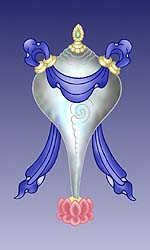The eight Buddhist auspicious symbols consist of - a parasol, pair of golden fish, the great treasure vase, a lotus, the right turning conch, the endless knot, the banner of victory and the wheel of dharma. These originated from a group of early Indian symbols of royalty which were presented at special ceremonies such as the coronation of a king. The symbols differed between different groups, for example the Jains and Newar Buddhists.
In Buddhism these symbols of good fortune represent the offerings that were made by the gods to Shakyamuni Buddha immediately after he attained enlightenment. Brahma appeared offering the thousand spoked golden wheel as a request to Shakyamuni to turn the teaching wheel of dharma. Indra appeared presenting the right spiraling conch shell as a symbol of the proclamation of the dharma and Sthavara presented the golden vase full of the nectar of immortality.

The Protection Parasol
The parasol or umbrella is an Indian symbol of both protection and royalty. The shadow protects from the heat and sun, and the coolness of the shade represents protection from the heat of suffering, desire, obstacles and illness. Different traditions have developed many designs of the parasol. The parasol dome can symbolise wisdom and the hanging skirt, compassion.

The Golden Fish
The golden fish symbolise happiness, due to their freedom in water, and fertility and abundance, due to their ability to multiply quickly.. The symbol is a common auspicious symbol in the Hindu, Jain and Buddhist traditions, which originated as being a symbol of the two main sacred rivers the Yamuna and Ganges in India, which represent the lunar and solar channels. In Egypt the pair of fishes symbolised the River Nile, and early Christianity adopted the symbol as an emblem of Christ.

The Great Treasure Vase
The Treasure Vase is modeled on the traditional Indian clay water pot. The Tibetan design is very ornate with lotus petal designs. The scarf is a silk cloth from the god realm and the upper opening is sealed with a wish granting tree, with the roots retaining the water of longevity to create all the treasures. The 'inexhaustible treasures' possess special qualities, so that however much is removed from the vase, it will always remain full. Therefore it symbolises long life and prosperity.

The White Lotus
The lotus is the symbol of purity. It is able to grow and blossom from the muddy water, and therefore is a symbol of divine generation. The lotus is used to depict this purity in different forms. The lotus on the throne implies immaculate conception and therefore the being is innately divine. Deities are often depicted holding a lotus as a symbol of their purity, compassion, renunciation and perfection of qualities.

The Right-Turning Conch
The conch shell is derived from ancient Indian stories that describe how heroes of mythical warfare carried a large while conch shell. It is a symbol of power and sovereignty, the sound believed to banish evil spirits, scare away harmful creatures and avert natural disasters. Buddhism adopted it as a symbol of religious sovereignty and an emblem that spreads the truth of dharma.

The Endless Knot
The endless knot overlaps without a beginning or an end, symbolising the Buddha's endless wisdom and compassion. It indicates continuity as the underlying reality of existence.

The Banner of Victory
The victory banner originates from the victory banner that was a military standard carried in Indian warfare. It was adopted as the symbol of Buddha's enlightenment. In Tibetan Buddhism it is said to symbolise the methods for overcoming the defilements-the development of knowledge, wisdom, compassion, meditation, and ethical vows.

The Wheel of Dharma
The wheel is an ancient Indian symbol of creation, sovereignty, and protection which represents motion, and change. Buddhism adopted the wheel to symbolise the Budhha's teachings, the wheel being identified as 'dharmachakra' or wheel of law. In Tibetan this means 'the wheel of transformation' or spiritual change, and can represent the overcoming of all obstacles and illusions.
No comments:
Post a Comment